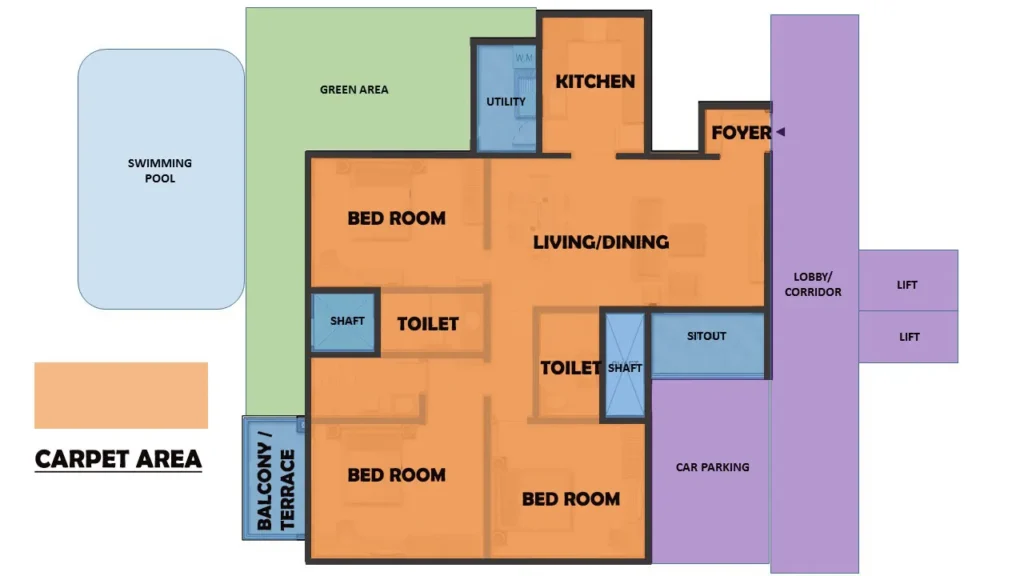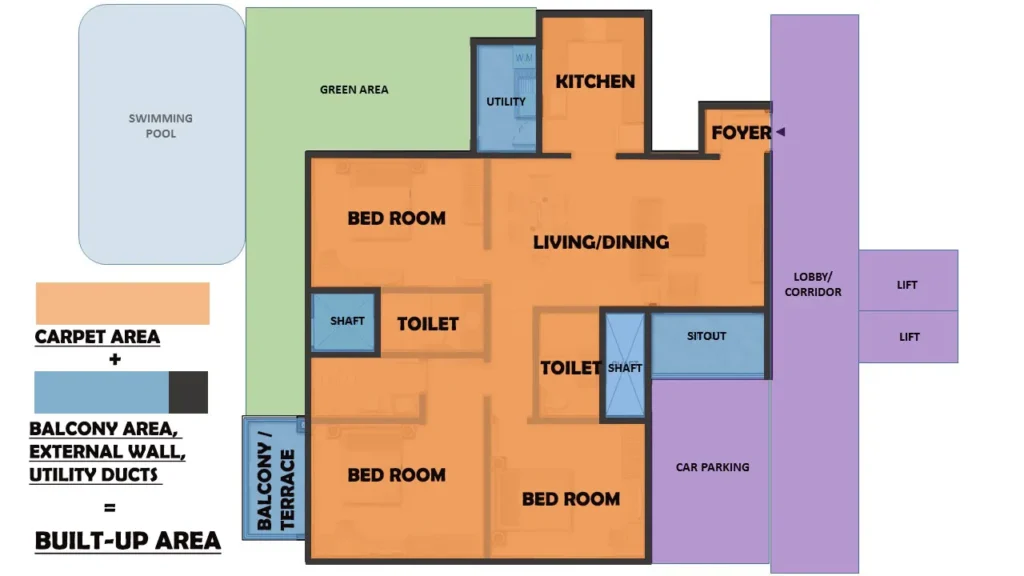If you want to know about the elements of design or parking and turning radius or stairwell pressurization system, please click the link.
In architecture, Carpet Area, Built-up Area, and Super Built-up Area are terms used to describe the size of a building or a unit within a building.
1) Carpet area
- The Real Estate Act has made it mandatory for developers to disclose the carpet area of the units that they sell.
Carpet area (Also known as RERA Carpet area)
- According to the Real Estate (Regulation and Development) Act, 2016 (RERA), carpet area is defined as “Carpet area” means the net usable floor area of an apartment, excluding the area covered by the external walls, areas under services shafts, exclusive balcony or verandah area and exclusive open terrace area, but includes the area covered by the internal partition walls of the apartment. As shown in the figure.

Carpet area (Including)
- Rooms – Living room, Bedrooms, Study, dining room, Dressing room, Other rooms.
- Kitchen and Bathrooms
- Stores
- Internal walls
- Cupboard spaces
- Staircase within property unit.
Carpet area (Excludes)
- External walls
- Service shafts
- Common areas – Lift, Staircase, Club house etc.
- Balconies, Terrace and Verandas
Difference b/w RERA Carpet area and actual Carpet area
Actual carpet area (Actual usable area)
- Area that can be used to spread a carpet inside the house.
- It does not include the thickness of the internal and external wall.
- It does not include the balcony, terrace of dry area
- Common areas – Lift, Staircase, Club house etc.
Note——–
- In RERA Carpet area include the internal thickness of the internal wall.
- Other thinks are reaming same.
- RERA Capet area > Actual carpet area.
2) Built-up area (plinth area)
- Built-Up Area is total covered area of the apartment or commercial property unit. It can be calculated by adding areas of utility ducts within property unit, internal and external walls to the carpet are. As shown in the figure.

Total independent area of the property unit, including
- Balcony area
- Carpet area
- External & Internal walls
- Utility ducts (water / sewer pipelines, A/C ducts, ventilation shaft) and Recesses (doors / windows).
- Built-up area = Carpet area + 10 % of Carpet area
3) Super Built-up area
- Super Built-Up Area is the built-up area plus proportionate area of common areas such as the lobby, lifts shaft, stairs, etc. Sometimes it may also include the common areas such, swimming pool, clubhouse, etc.
- Generally, CARPET AREA is around (70 to 80) % of SUPER BUILT UP AREA. But note that this percentage varies from project to project and builder to builder.
- Payment is made on “SUPER BUILT UP AREA”.

Super built-up area = built-up area + Common area
Super Built-up area (Includes)
- Entire built-up area of the unit.
- Built-up common areas – Lobby, Lift shaft, Staircase, Pipe ducts/shafts, Air ducts, Covered club house, other covered common facilities.
Super Built-up area (Excludes)
- Roof terrace
- Open areas – Parks, Gardens, Play areas, Driveways etc.
Note——- Approximation (Super built-up area = Carpet area + 25 to 40 % of Carpet area)
Example
If CARPET AREA is 600 sq ft. What would be SUPER BUILT-UP AREA?
Ans.) Let’s assume the ratio is 75:25.
4) What is Loading factor
- Percentage (%) difference between Carpet area and Super built-up area.
If Super built-up area = 1000 sq.ft and Carpet area = 700 sq.ft.
Formula, Super built-up area = Carper area (1+Loading factor)
Then, Loading factor = .43 or 43%
Built-up area = (Carpet area+10 % of Carpet area)
= (700+70)
= 770 sq.ft.
5) Common areas (Mean) According to RERA.
- The entire land for the real estate project or where the project is developed in phases and registration under this Act is sought for a phase, the entire land for that phase; the staircases, lifts, staircase and lift lobbies, fire escapes, and common entrances and exits of buildings.
- The common basements, terraces, parks, play areas, open parking areas and common storage spaces.
- The premises for the lodging of persons employed for the management of the property including accommodation for watch and ward staffs or for the lodging of community service personnel.
- Installations of central services such as electricity, gas, water and sanitation, air-conditioning and incinerating, system for water conservation and renewable energy; the water tanks, sumps, motors, fans, compressors, ducts and all apparatus connected with installations for common use.
- All community and commercial facilities as provided in the real estate project.
- All other portion of the project necessary or convenient for its maintenance, safety, etc., and in common use.
Understanding these terms is important in real estate transactions as they can affect the pricing and the amount of usable space in a building or unit.